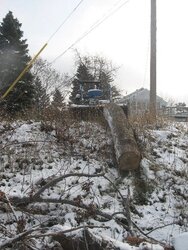Greetings folks:
I'm thinking about purchasing a winch setup and would appreciate some feedback/ideas. The situation is that my very hilly property is simply filthy with wood.....ash, oak, cherry and birch. The problem is that getting the wood to flat ground for bucking, splitting and stacking would require more time and energy than I have. So, it gots me thinking to mount a winch on the back of my V-8 Explorer via the class III hitch as I can get teh vehicle close enough to most of it for harvesting. Here's what I think I need...
-Winch: something in the 4000 lb range. Can I use an ATV winch mounted to a Class III receiver plate?
-Additional winch cable
-Battery/power leads wired to the back of the truck
-Sheave blocks
Is this feasible or would I be embarking on an absolute boondoggle? Please let me know, thanks.
I'm thinking about purchasing a winch setup and would appreciate some feedback/ideas. The situation is that my very hilly property is simply filthy with wood.....ash, oak, cherry and birch. The problem is that getting the wood to flat ground for bucking, splitting and stacking would require more time and energy than I have. So, it gots me thinking to mount a winch on the back of my V-8 Explorer via the class III hitch as I can get teh vehicle close enough to most of it for harvesting. Here's what I think I need...
-Winch: something in the 4000 lb range. Can I use an ATV winch mounted to a Class III receiver plate?
-Additional winch cable
-Battery/power leads wired to the back of the truck
-Sheave blocks
Is this feasible or would I be embarking on an absolute boondoggle? Please let me know, thanks.


